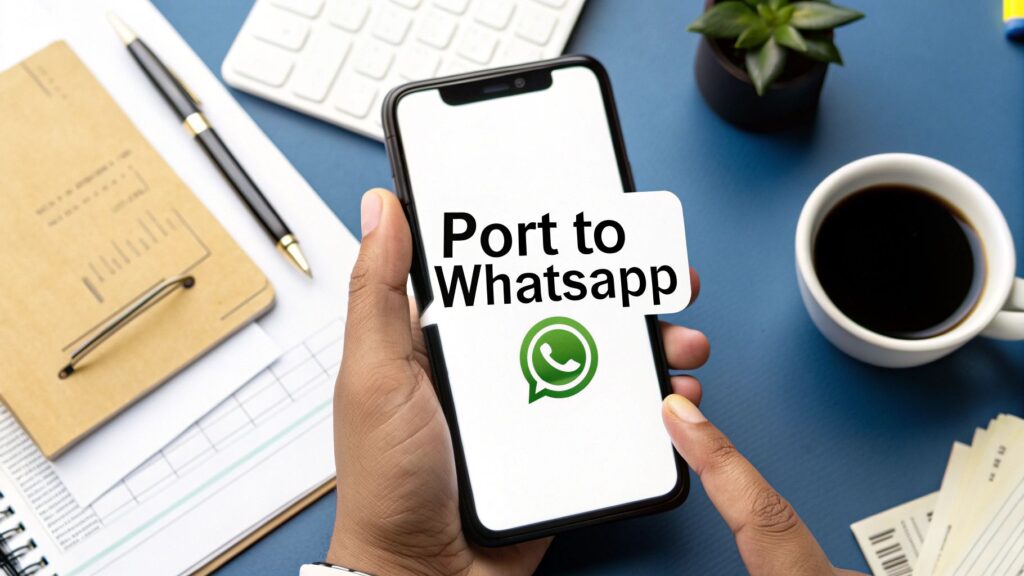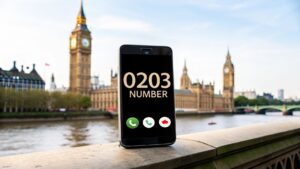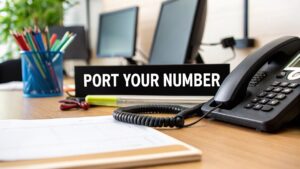When you hear the term 'telephone number transfer' or 'porting', it simply means moving your existing phone number from one service provider to another. In this guide, we're focusing on a smart business move: taking the number your customers already know and connecting it to a virtual platform for WhatsApp Business. The best part? You don't even need a physical SIM card.
How a Telephone Number Transfer Really Works

Ready to bring your trusted business number over to WhatsApp? The idea of a telephone number transfer can sound a bit technical, but it’s actually a well-established process designed to give you more freedom. Think of it less as a chore and more as a strategic move to bring all your customer conversations into one convenient place.
At its core, the process involves three key players: your current provider (the one you're leaving), your new virtual number provider, and WhatsApp itself. The entire operation is about untethering your number from a physical SIM card or landline and plugging it straight into a flexible, app-based service.
Understanding Who Does What
Your current provider—whether it's a major mobile network or a landline company—is what we call the 'losing' provider. Here in the UK, you have a regulated right to take your number with you, so they have a standard procedure to let it go. Your main task with them is simply getting the correct details to authorise the move.
The 'gaining' provider is your new virtual number service, like Business Numbers Direct. These are the experts who do the heavy lifting. Once you’ve signed up and given them the green light, they coordinate with your old provider to take control of the number. Instead of routing calls to a SIM, they'll direct everything to their app, ready for you to use with WhatsApp.
Finally, you have WhatsApp Business, which is your ultimate destination. Once the porting is complete, you'll use that familiar number to verify your WhatsApp Business account. This crucial step proves you own the number and officially links it to your business profile on the platform.
This isn't just about switching technology. It's about meeting customers where they are. With over 2 billion active users globally, WhatsApp is a dominant communication channel. Using your established business number there offers a seamless, professional touch that customers trust and appreciate.
The Core Transfer Journey
To get things started, you'll kick off a porting request with your chosen virtual provider. This usually involves filling out a form with your account details and the number you want to move. This single action sets off a chain of communication between the two providers behind the scenes.
To give you a clearer picture, here’s a quick summary of what happens during the transfer.
Key Stages of a Number Transfer
| Stage | What You Do | What It Achieves |
|---|---|---|
| Initiation | Submit a transfer request to your new virtual provider. | This officially starts the porting process and notifies both providers. |
| Authorisation | Provide the necessary details from your old account. | Your new provider can now legally request the number from your old one. |
| Activation | Wait for confirmation that the transfer is complete. | Your number is now live on the new virtual platform, free from its old SIM. |
| Verification | Enter your number in the WhatsApp Business app and verify it. | This links your trusted number to your WhatsApp Business profile. |
This entire process is carefully structured to ensure your number is never left in limbo. Your service with the old provider continues to work right up until the switch happens, meaning you won't miss any calls. It’s a smooth and coordinated transition to a much more modern way of handling your business communications.
Getting Your Ducks in a Row: The Pre-Transfer Checklist
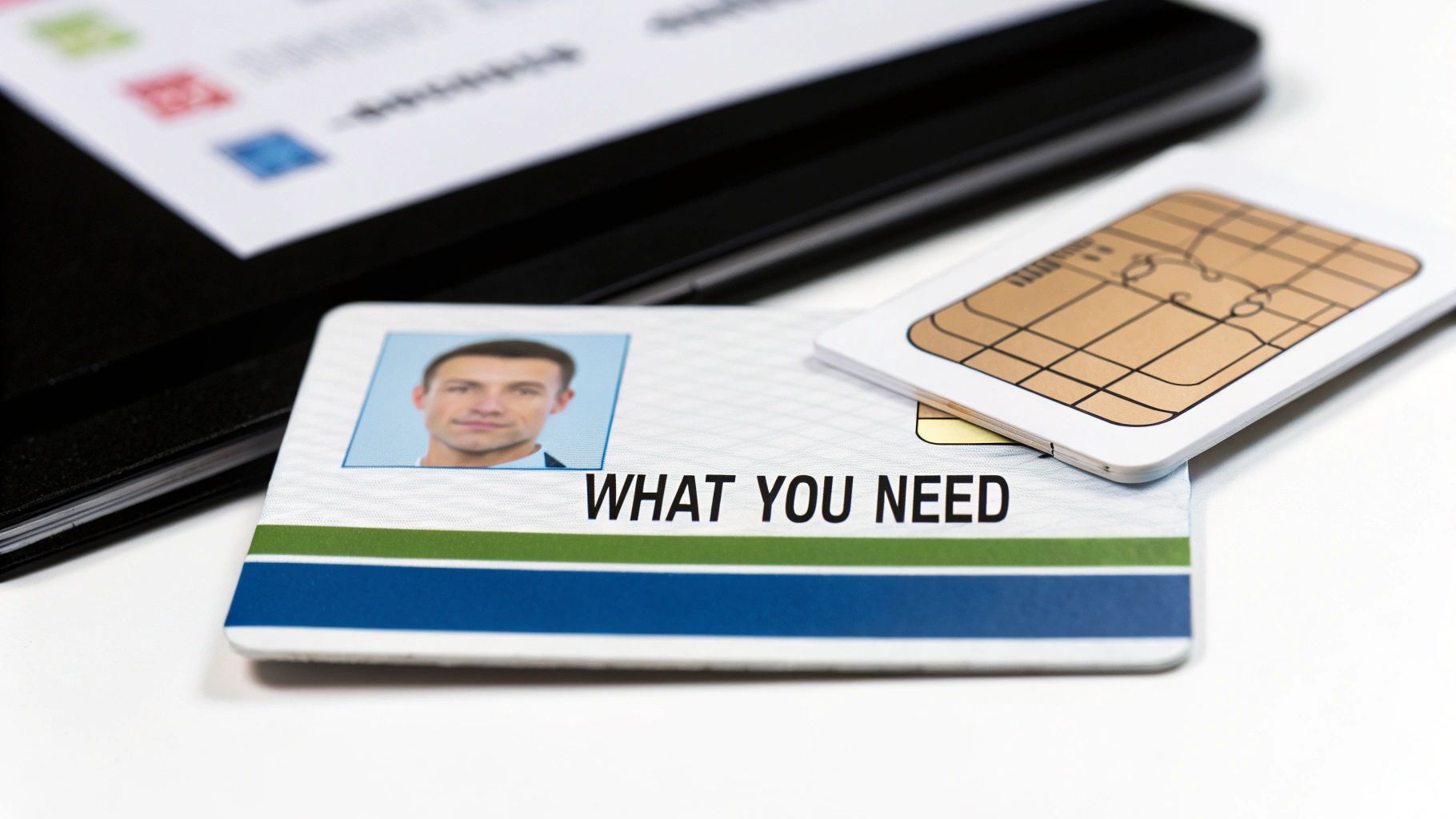
A successful number transfer starts long before you fill out any forms. Think of it like packing for a trip—a little preparation ensures you don't get stuck halfway to your destination. Getting your details straight from the outset is the single best way to avoid the common pitfalls and delays that can trip people up.
Believe it or not, the most frequent reason a transfer fails is a simple data mismatch. The information you give your new provider must be a 100% perfect match to what your current provider has on file. Even a tiny error, like a slightly different postcode or a misspelled business name, can grind the whole thing to a halt.
First, Confirm Ownership and Check Eligibility
Before you go any further, you need to be absolutely sure of two things: that you are the legal owner of the number, and that the number itself is eligible to be moved. Not all numbers can be transferred. Some get tangled up in bundled service packages or locked into proprietary systems with their own restrictions.
So, let's get your information gathered. You'll need:
- Your Exact Account Number: This is rarely your phone number. You'll find it on a recent bill or by logging into your provider's online portal.
- The Service Address on File: This is the physical address your current provider has registered for your account. It must match exactly, right down to the last letter of the postcode.
- The Registered Name: Make sure you have the precise name of the account holder, whether that's your personal name or your official registered business name.
Getting these details right is non-negotiable. If they don't match, your transfer request will be rejected almost instantly, and you'll be right back at square one.
Have a Quiet Word with Your Current Provider
This next step is crucial. Before you initiate the switch, it’s a very smart idea to get in touch with your current provider. The key here is your approach. You're not calling to tell them you're leaving—in fact, doing so can sometimes cause them to cancel your service prematurely, which you definitely don't want.
Instead, you're on a fact-finding mission.
Frame the conversation as a routine account check-up. Simply ask them to confirm your account number, billing address, and any security PINs or passwords tied to the account. This is also the perfect time to check for any outstanding balances or contractual obligations that could block the transfer.
For example, if your number is part of a business contract that hasn't run its course, you might be liable for an early termination fee. A quick, friendly call can bring potential roadblocks like this to light before they become a real headache.
Make sure you also ask them about their specific process for porting a number out. They are legally required to give you this information, and this single conversation can save you weeks of frustrating back-and-forth later on.
Getting Stuck into the Actual Porting Process
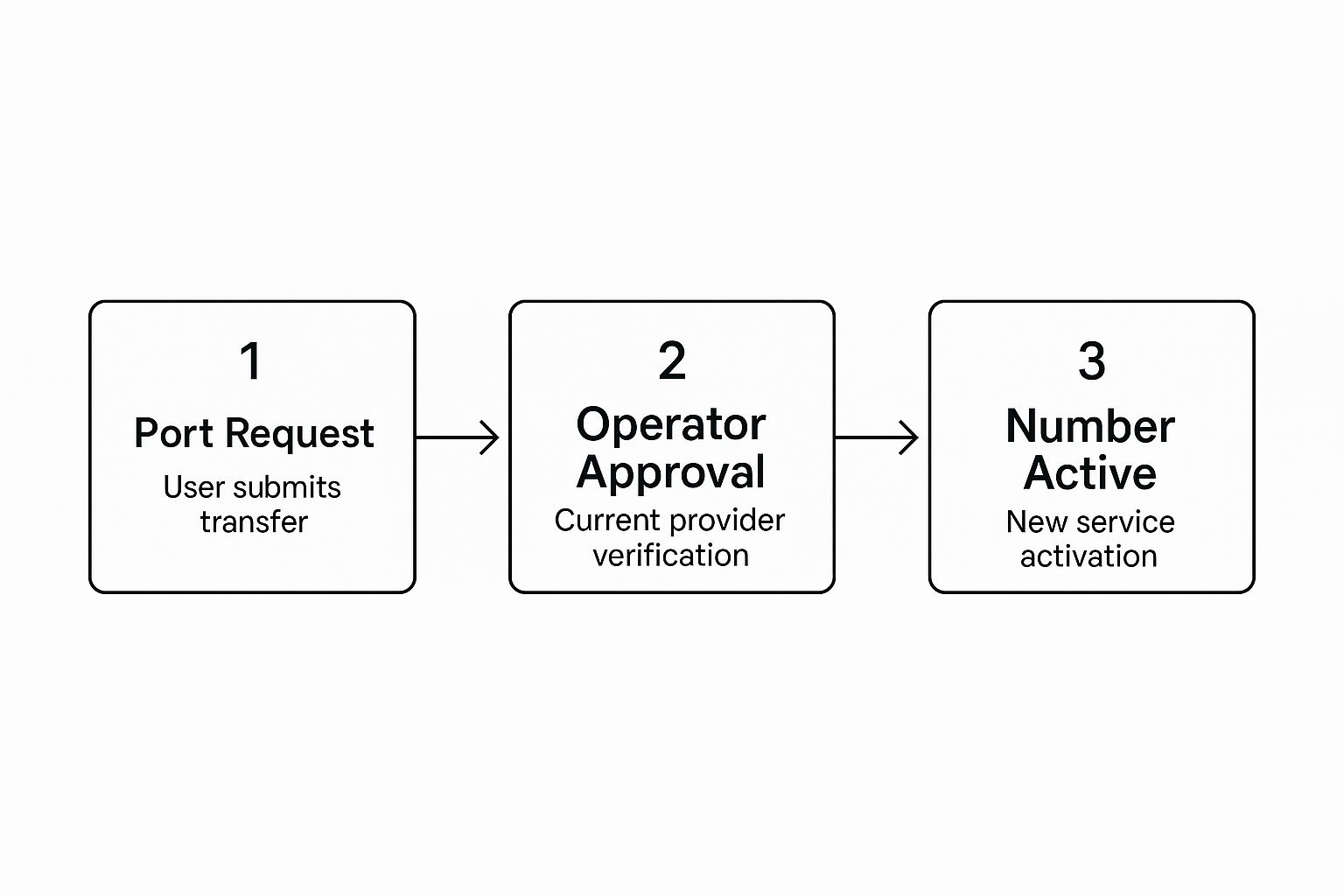
Alright, you've done the prep work. Now it's time to get into the nitty-gritty of the telephone number transfer itself. This is where your planning pays off and you get the ball rolling. Honestly, the process is a lot less daunting than it sounds once you know what's coming.
Your first move is to pick a virtual number provider that knows the ropes when it comes to WhatsApp Business, like Business Numbers Direct. A solid provider does more than just flick a switch; they’ll guide you through the process, keeping you in the loop and offering support. Once you've signed up with them, you’re ready to put in the official porting request.
As you can see from the journey so far, after you submit your request, the key part is the handshake between your old and new network operators. Once they give the thumbs-up, your number officially becomes active on its new home.
Getting the Go-Ahead: Your Authorisation Details
First things first, you need to prove you have the right to move the number. The specific information you'll need depends on whether it’s a mobile or a landline number you’re bringing over.
For a UK mobile, it’s all about the Porting Authorisation Code (PAC). Getting this is incredibly simple. Thanks to Ofcom rules, you just text 'PAC' to 65075 from the SIM card tied to the number. You’ll get a text back with your code almost instantly, and it stays valid for 30 days.
Moving a landline works a bit differently because there's no PAC system. Instead, you'll rely on the account details you gathered earlier:
- The full name on the account.
- The service address and postcode, exactly as they appear on your bill.
- Your account number with your current provider.
Think of these details as the 'password' that authorises the landline transfer.
Filling in the Porting Form
With your PAC or landline details in hand, you'll move on to your new provider’s porting form. This is usually just a straightforward online form asking for the number you’re transferring and the authorisation info you just collected.
Take your time here. Accuracy is everything. Hitting 'submit' on this form is what officially kicks off the transfer. Your new provider uses this information to make a formal request to your old one. Any small mistake or typo will cause an automated system to reject the request, sending you back to the start.
A Quick Tip from Experience: Be strategic about when you port. I always advise clients to aim for a quieter day in the middle of the week, like a Tuesday or Wednesday. This gives you some breathing room to get everything set up and tested without the stress of your busiest customer periods.
How Long Will This All Take?
It’s crucial to have a realistic idea of the timeline. A telephone number transfer doesn't happen in a flash; it requires the two providers to coordinate behind the scenes.
Here's a rough guide for how long it typically takes in the UK:
| Number Type | Typical Transfer Time | Why the Difference? |
|---|---|---|
| Mobile Number | 1-2 working days | The process is highly automated with the PAC system. |
| Landline Number | 1-4 weeks | This is a more manual process involving complex network coordination. |
A mobile number transfer is often completed by the end of the next working day, provided you submit your PAC before the daily cut-off (usually around 5 pm). Landlines, however, are a longer game. Your new provider will give you a specific porting date. The good news is your service will carry on as normal with your old provider right up until that date, so there’s no downtime. It's a managed process designed for a smooth switch.
Getting Your Ported Number Hooked Up to WhatsApp Business
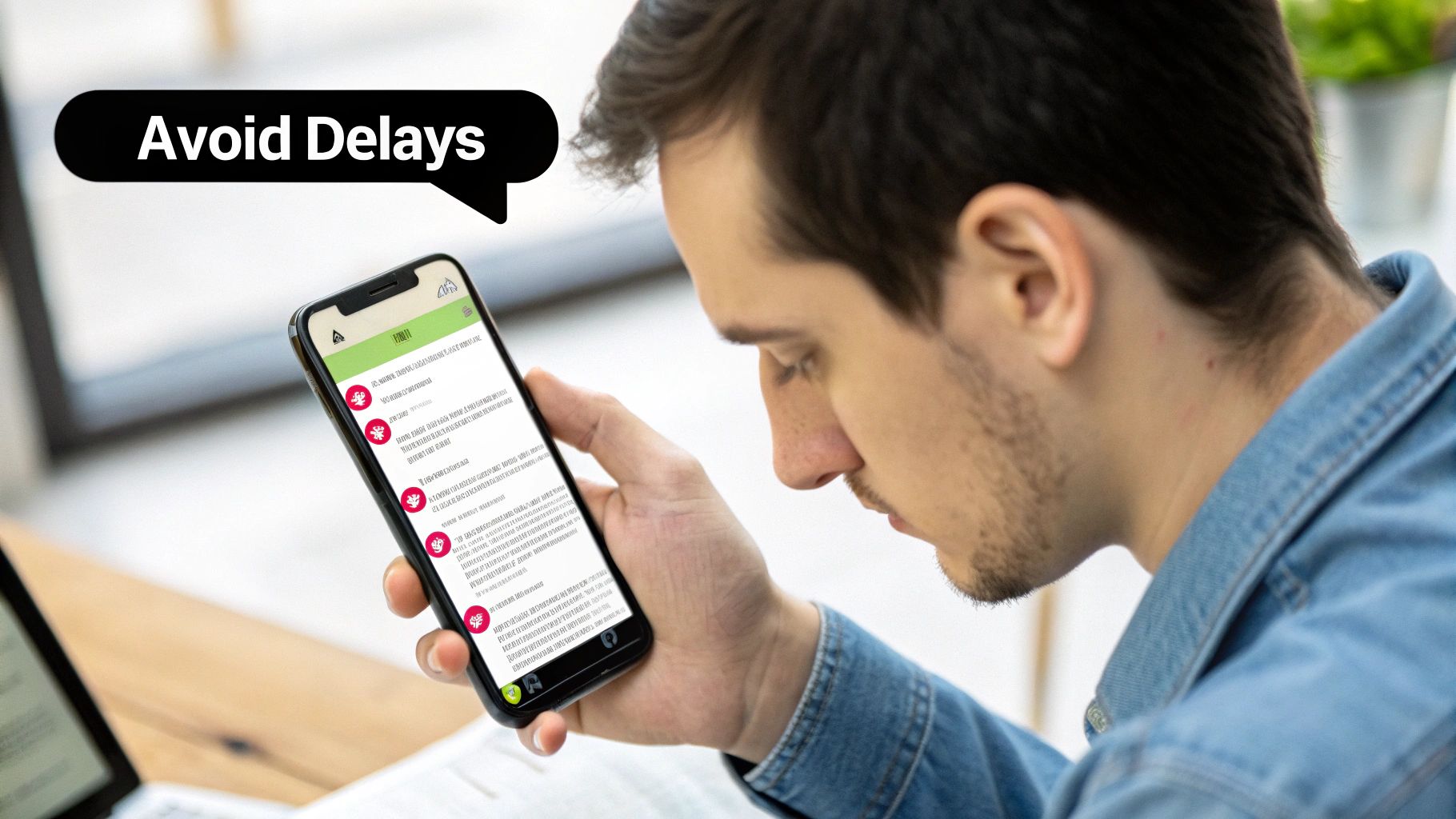
So, your number has successfully moved across from your old provider. That's a huge milestone in the telephone number transfer journey, but we're not quite at the finish line. Now comes the final, vital step: connecting it to your WhatsApp Business account. This part isn't automatic, and it's where some people get a bit stuck.
The main challenge is that you no longer have a physical SIM card for that number. This means when WhatsApp tries to send its standard SMS verification code, it has nowhere to go. Don't worry, though—there’s a simple and effective workaround built right into the app.
The 'Call Me' Verification Trick
The secret to linking your newly ported virtual number is the 'Call me' option on the WhatsApp Business verification screen. Instead of waiting for an SMS that will never arrive, you simply tell WhatsApp to phone you with an automated call.
This call won't ring your mobile's regular phone app. Instead, it will come through the app of your new virtual number provider, like Business Numbers Direct. Just make sure you're logged into that provider's app with notifications switched on.
When you answer, an automated voice will read out your six-digit verification code. Pop that code into WhatsApp Business, and you're in. It’s a clever little solution that bridges the gap between a virtual number and WhatsApp's security check.
Building Your Professional Profile
Once your number is verified, you’re officially live on WhatsApp Business. Before you dive into messaging customers, take a few minutes to complete your profile. This is your digital shopfront and your chance to make a brilliant first impression. An incomplete profile can look unprofessional and might even put potential customers off.
Think of your WhatsApp Business profile as a mini-website. It’s often the first place a new customer will look for essential information. Filling it out completely builds trust and makes it far easier for people to do business with you.
A well-crafted profile gives customers all the key details they need at a glance, saving both of you time. It immediately shows you're a legitimate, organised business.
Here are the absolute essentials you should fill out:
- Business Name: Your official trading name.
- Profile Picture: Your company logo works best for instant brand recognition.
- Business Description: A short, clear summary of what you do.
- Business Address: Add your physical location if you have one, or just your city.
- Business Hours: Let customers know when you're available to respond.
- Email Address: Give people another way to get in touch.
- Website: Link directly to your site to drive more traffic.
For instance, a local plumber might list his service area in the description and set clear working hours. An e-commerce store could use the profile to link directly to its main product pages. Taking just 10 minutes to get this right establishes your credibility from the get-go and sets a professional tone for every customer interaction that follows. It's a small task that pays big dividends in customer confidence.
Why You Can Keep Your UK Number When You Switch
Ever wondered how you can take your existing business number with you when you move to a new provider? It’s not just a nice customer service perk; it’s a fundamental right, backed by regulation, that gives UK businesses genuine freedom and control. This right is the very foundation of a successful telephone number transfer.
This customer-first system didn’t just happen overnight. It was the result of a deliberate push to inject serious competition into the UK's telecommunications market. The driving force behind it was the Office of Telecommunications (Oftel), which you’ll now know as Ofcom. Throughout the 1990s, their mission was to dismantle monopolies and give customers real choice.
The Dawn of Telephone Number Portability
The game-changer was the introduction of Telephone Number Portability (TNP). This regulation forces providers to let you keep your number when you decide to switch. Before TNP, your number was essentially owned by your provider, locking you into their service. Leaving meant getting a new number—a huge headache for any business trying to maintain contact with its customers.
The groundwork was laid with events like 'PhONEday' back in 1995, which helped standardise UK area codes for a more adaptable network. From there, the ability to move numbers between providers was gradually rolled out. We saw full portability for fixed lines by 1997, with mobile numbers following in 1999. It was a pivotal moment for UK telecoms. You can dive deeper into the history of UK telephone numbers on Wikipedia if you're curious.
Suddenly, providers had to compete on what actually matters—price, service quality, and innovation—rather than simply holding your number hostage.
The ability to keep your number is a right, not a privilege. It ensures business continuity and empowers you to choose the best service for your needs—like moving to a virtual number for WhatsApp Business—without disrupting your customer relationships.
What This Means for Your Business Today
Thanks to all that groundwork, you can now confidently move your trusted landline or mobile number over to a modern virtual provider like Business Numbers Direct. The whole process, from getting your PAC code to the final handover, is governed by these well-established Ofcom rules.
This framework ensures the switch is smooth and predictable, compelling your old provider to cooperate with your new one. It’s precisely why you can embrace new ways of communicating without losing the brand recognition and customer trust you’ve worked so hard to build. It puts the power squarely back where it belongs: in your hands.
Got Questions About Porting Your Number?
It's completely normal to have questions when you're thinking about moving your business phone number. This number is a core part of your business identity, so you want to be sure you're making the right move. The good news is that the whole process is much more straightforward than it might seem.
We’ve guided countless businesses through this process, so we’ve put together answers to the most common queries we hear. Let’s clear things up so you can move forward with confidence.
How Long Does a Telephone Number Transfer Take in the UK?
This is usually the first thing everyone wants to know. The timeline really depends on what kind of number you're bringing over.
If it’s a UK mobile number, you're in luck. The PAC code system is incredibly efficient, meaning the transfer is typically completed within one working day.
Landline numbers, on the other hand, are a bit more old-school. Moving a geographic number involves more manual legwork behind the scenes between network providers. Because of this, you should plan for it to take anywhere from one to four weeks. It's wise to build this timeframe into your plans to avoid any disruption.
Can I Still Make Phone Calls After Transferring My Number?
Absolutely, and this is a point that often surprises people. When you port your number to a virtual service, you’re not losing its original function; you're upgrading it.
Bringing your number to a provider like Business Numbers Direct means it becomes a fully-featured VoIP (Voice over Internet Protocol) phone line.
What does this mean for you? You can make and receive regular phone calls through an app on your smartphone or a dashboard on your computer. All your business communication, from WhatsApp chats to traditional calls, is managed under that one, professional number.
What Happens If My Number Transfer Fails?
First and foremost, don't panic. If a telephone number transfer hits a snag, your number is completely safe. You won't lose it. Your service simply continues as normal with your current provider while the problem gets sorted out.
Nine times out of ten, a failure comes down to a simple mismatch in the details provided. We see the same few issues pop up time and again:
- A slight difference in the postcode or business address held on file.
- An incorrect account number was submitted.
- There's an outstanding bill with your old provider.
Your new provider is told exactly why the transfer was rejected. They'll then contact you, explain the issue, and help you correct the information so you can resubmit the request and get it approved.
Ready to take control of your business communications? With Business Numbers Direct, you can set up a dedicated virtual number for WhatsApp Business in minutes, keeping your personal and professional lives separate. Start your journey for just £7.99 per month.

